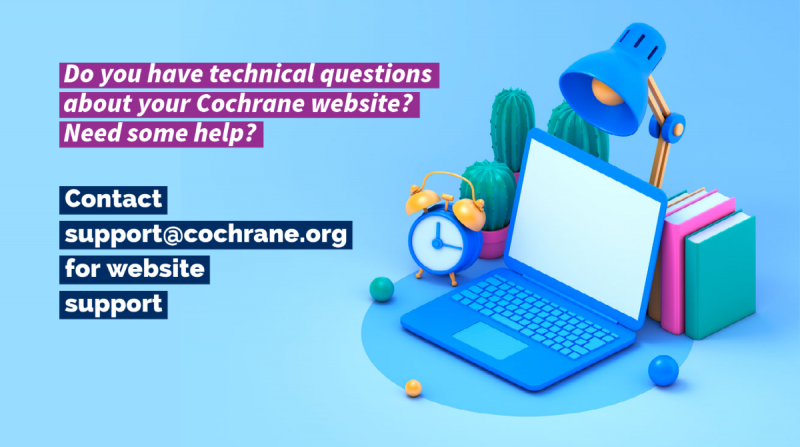

Muriah Umoquit, Communications and Analytics Officer with Cochrane’s Knowledge Translation Department, and Paolo Rosati, Web Operations Manager with Cochrane’s Information and Technology Department, share their top tips for creating a low maintenance website
Most Cochrane groups are granted their own website - it’s a place to highlight your achievements, showcase your best work, and be a landing spot for anyone searching the web for information about your work. However, sometimes due to capacity issues, websites are left neglected and outdated. This can send the wrong message to visitors…sometimes even to funders!
This blog posts offers you our top five tips for creating your best digital footprint, while keeping the maintenance low.
1. Content for the end user
Who do you want to use your website? People using the evidence (public, clinicians policy makers)? Your review authors? Your funders? A mix of audiences? Taking some time to answer these questions can help you make the decisions about the type of content you share.
Keeping your audience in mind, take a look at what is already on your website. If it's not specific to your Group, you could just redirect them. For example, Cochrane Authors don't need to come to your site for latest in training that you would then need maintain - instead, redirect them to the Cochrane Training website.
2. Cover the basics
We recommend that you have at the minimum three pages with static content.
- About Us - this can be your landing/front page if you'd like. This should cover the scope of what your group covers and explain in plain language what your group does. If you need to display logo's of your Funders, this is a great spot them.
- Contact us - provide your email address! Other things to include could be any social media accounts that you maintain.
- Join Cochrane or Join Us - people looking to get involved with your group can now be funneled directly to the 'Join Cochrane' pages; less work for you handling inquiries and ensures people get assigned membership points for the work they do.
After you have covered the basics, then see if you have the capacity for regular news items. Only if you think you have time to maintain things, add in non-static pages, like news items that show up on https://[yourwebsite]/news. If you don't have time to post news items regularly, you don't need to. You are not required to use the format of having Feature Items and News on your front page (like here on the Community website); this feature is optional. Any information on your front landing page should be current and should speak to your target users - ensure that you are promoting the most important information for you group!
3. Automate!
There are several things that you can have update on your page with no additional work for you once set-up. These include:
- Twitter feed - If you have a Twitter account, consider it being added to your landing page or other relevant page. Whenever you tweet, it will automatically show up in this feed.
- News feed - If you have trouble adding news to your website, you can add a feed for any news posted on Cochrane.org or a particular Network to show up on website in a feed.
- Evidence feed - If you are a review group, consider having a page labeled 'Our Evidence' or 'Our Reviews' where reviews that are produced by your group will automatically show up - see an example here.
4. Get social
Maintaining social media accounts for your group is optional. If you do have a social media account, provide links to the accounts to make it easy to find them. The right-hand side of your landing page is a great place for this or you may wish to add them to the Contact Us page if you have several accounts. As mentioned above, you can also add a feed of your Twitter account on the right-hand side of your landing page. If you don't have any social media accounts you can list the Cochrane and Cochrane Library ones.
5. Maintain
Once your website is set-up with static and automated content, that doesn't mean you can just forget about it! On page 9 of the website admin manual we suggest quarterly and provide a list of things to check on. If things are pretty static, this won't take you long at all!

Get help implementing these 5 tips!
Removing the news boxes from your front page, adding in feeds, adjusting your tabs, adding in a language toggle to support translations - these can be tricky things to do because they aren't things you do often! We do have a page on Cochrane Community for webmasters, as well as a detailed website admin manual. You are also welcome to contact support@cochrane.org and we can give you hand and direct you to the information needed! Setting your website up for your particular audience and for your capacity levels take a bit of work but having a polished virtual space on the internet for your group's information is worth the effort!
Sources of further information:
- Cochrane webmasters information
- Cochrane website admin manual
- Technical questions and help requests can be sent to support@cochrane.org.

